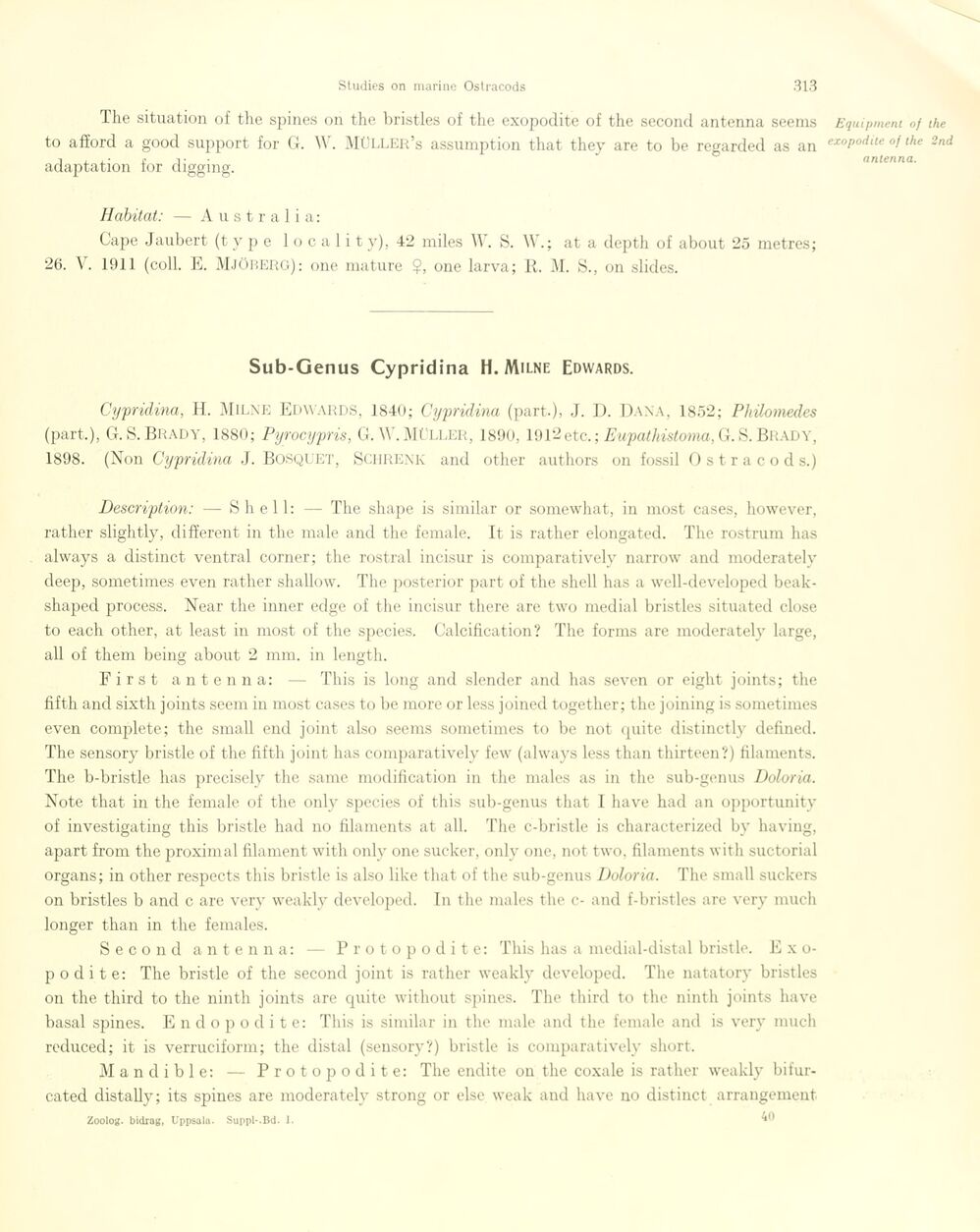
Full resolution (JPEG) - On this page / på denna sida - Sidor ...

<< prev. page << föreg. sida << >> nästa sida >> next page >>
Below is the raw OCR text
from the above scanned image.
Do you see an error? Proofread the page now!
Här nedan syns maskintolkade texten från faksimilbilden ovan.
Ser du något fel? Korrekturläs sidan nu!
This page has never been proofread. / Denna sida har aldrig korrekturlästs.
The situation of the spines on the bristles of the exopodite of the second antenna seems
to afïord a good support for G. W. MULLER’s assumption that they are to be regarded as an
adaptation for digging.
Habitat: — Australia:
Cape Jaubert (type 1 o c a 1 i t y), 42 miles W. S. W.; at a depth of about 25 metres;
26. V. 1911 (coll. E. Mjöberg): one mature $, one larva; R. M. S., on slides.
Sub-Genus Cypridina H. Milne Edwards.
Cypridina, H. MlLNE EDWARDS, 1840; Cypridina (part.), J. D. Dana, 1852; Philomedes
(part.), G. S. Brady, 1880; Pyrocypris, G. W. MÜLLER, 1890, 1912etc. ; Eupathistoma, G. S. BRADY,
1898. (Non Cypridina J. BOSQUET, SCHRENK and other authors on fossil Ostracods.)
Description: — Shell: — The shape is similar or somewhat, in most cases, however,
rather slightly, different in the male and the female. It is rather elongated. The rostrum has
always a distinct ventral corner; the rostral incisur is comparatively narrow and moderately
deep, sometimes even rather shallow. The posterior part of the shell has a well-developed
beak-shaped process. Near the inner edge of the incisur there are two medial bristles situated close
to each other, at least in most of the species. Calcification? The forms are moderately large,
ail of them being about 2 mm. in length.
First antenna: — This is long and siender and has seven or eight joints; the
fifth and sixth joints seem in most cases to be more or less joined together; the joining is sometimes
even complete; the small end joint also seems sometimes to be not quite distinctly defined.
The sensory bristle of the fifth joint has comparatively few (always less than thirteen?) filaments.
The b-bristle has precisely the same modification in the males as in the sub-genus Doloria.
Note that in the female of the only species of this sub-genus that I have had an opportunity
of investigating this bristle had no filaments at all. The c-bristle is characterized by having,
apart from the proximal filament with only one sucker, only one, not two, filaments with suctorial
organs; in other respects this bristle is also like that of the sub-genus Doloria. The small suckers
on bristles b and c are very weakly developed. In the males the c- and f-bristles are very much
longer than in the females.
Second antenna: — Protopo dite: This has a medial-distal bristle. E x
o-p o dite: The bristle of the second joint is rather weakly developed. The natatory bristles
on the third to the ninth joints are quite without spines. The third to the ninth joints have
basal spines. Endopodite: This is similar in the male and the female and is very much
reduced; it is verruciform; the distal (sensory?) bristle is comparatively short.
Mandible: — Protopodite: The endite on the coxale is rather weakly
bifur-cated distally; its spines are moderately strong or else weak and have no distinct arrangement
Zoolog, bidrag, Uppsala. Suppl-.Bd. 1. ^0
Equipment of the
exopodite of the 2nd
antenna.
<< prev. page << föreg. sida << >> nästa sida >> next page >>